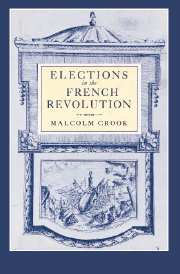Book contents
- Frontmatter
- Contents
- List of maps
- List of tables
- Acknowledgements
- List of abbreviations
- Introduction
- 1 Subjects to citizens? The elections to the Estates General and the Revolution
- 2 Limits of citizenship: The franchise question, 1789–1791
- 3 Biting on the ballot: From enthusiasm to abstention, 1790–1791
- 4 One man one vote? The experiment with electoral democracy in 1792
- 5 Voting the Constitution: The referenda of 1793 and 1795
- 6 Parties, schisms and purges: Elections under the Directory, 1795–1799
- 7 An invisible aristocracy? The departmental assemblies and the emergence of a new political class
- Conclusion
- Bibliography
- Index
5 - Voting the Constitution: The referenda of 1793 and 1795
Published online by Cambridge University Press: 03 November 2009
- Frontmatter
- Contents
- List of maps
- List of tables
- Acknowledgements
- List of abbreviations
- Introduction
- 1 Subjects to citizens? The elections to the Estates General and the Revolution
- 2 Limits of citizenship: The franchise question, 1789–1791
- 3 Biting on the ballot: From enthusiasm to abstention, 1790–1791
- 4 One man one vote? The experiment with electoral democracy in 1792
- 5 Voting the Constitution: The referenda of 1793 and 1795
- 6 Parties, schisms and purges: Elections under the Directory, 1795–1799
- 7 An invisible aristocracy? The departmental assemblies and the emergence of a new political class
- Conclusion
- Bibliography
- Index
Summary
The National Convention was first and foremost a constituent assembly and, during the three turbulent years of its existence, two Constitutions were drafted. The first, that of 1793 (or Year I of the republican era), was set aside ‘until circumstances permitted’. It was never implemented because when stability of a sort did return, after Thermidor (July 1794), less radical ideas prevailed. A more conservative Constitution, that of 1795 (or the Year III), was devised to replace it. This time the document was put into immediate effect and the Convention finally separated. Between its creation in the summer of 1792 and its dissolution in the autumn of 1795 no legislative elections had taken place in France; only at the local level were a few assemblies convened for municipal and judicial purposes. The electorate was instead given an unprecedented opportunity to participate in two constitutional referenda, the first of which was held in the summer of 1793.
On 21 September 1792, the day after it assembled, the Convention boldly declared: ‘Before it can be put into effect any constitution must be endorsed by the people.’ The idea of a popular consultation had been mooted in the Constituent Assembly by Pétion as early as September 1789. He suggested that the people should be called upon to arbitrate in the case of deadlock between king and assembly, by simply voting in favour of one side or the other. His colleagues were unimpressed and subsequently refused to submit the Constitution of 1791 to the electorate for ratification. Demands for a ‘referendum’ of this sort were supported by conservative deputies like Malouet, but rejected on the grounds that the National Assembly already incarnated the will of the nation.
- Type
- Chapter
- Information
- Elections in the French RevolutionAn Apprenticeship in Democracy, 1789–1799, pp. 102 - 130Publisher: Cambridge University PressPrint publication year: 1996

